
Philip St. John Basil Rathbone MC was a South African–born English actor. He rose to prominence in the United Kingdom as a Shakespearean stage actor and went on to appear in more than 70 films, primarily costume dramas, swashbucklers, and, occasionally, horror films.
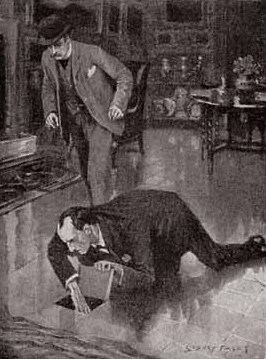
"The Adventure of the Second Stain", one of the 56 Sherlock Holmes short stories written by Sir Arthur Conan Doyle, is one of 13 stories in the cycle collected as The Return of Sherlock Holmes (1905) and the only unrecorded case mentioned passively by Watson to be written. It was first published in The Strand Magazine in the United Kingdom in December 1904, and was also published in Collier's in the United States on 28 January 1905. Doyle ranked "The Adventure of the Second Stain" eighth in his list of his twelve favourite Holmes stories.
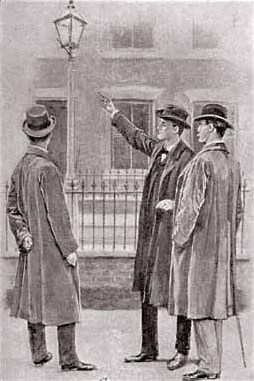
"The Adventure of the Six Napoleons", one of the 56 Sherlock Holmes short stories written by Sir Arthur Conan Doyle, is one of 13 stories in the cycle collected as The Return of Sherlock Holmes. It was first published in Collier's in the United States on 30 April 1904, and in The Strand Magazine in the United Kingdom in May 1904.

"The Adventure of the Golden Pince-Nez", one of the 56 Sherlock Holmes short stories written by Sir Arthur Conan Doyle, is one of 13 stories in the cycle collected as The Return of Sherlock Holmes (1905). It was first published in The Strand Magazine in the United Kingdom in July 1904, and was also published in Collier's in the United States in October 1904.

The Pearl of Death is a 1944 Sherlock Holmes film starring Basil Rathbone as Holmes and Nigel Bruce as Dr. Watson, the ninth of fourteen such films the pair made. The story is loosely based on Conan Doyle's short story "The Adventure of the Six Napoleons" but features some additions, such as Evelyn Ankers as an accomplice of the villain, played by Miles Mander, and Rondo Hatton as a brutal killer.
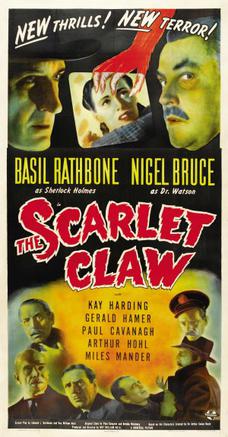
The Scarlet Claw is a 1944 American mystery thriller film based on Sir Arthur Conan Doyle's Sherlock Holmes detective stories. Directed by Roy William Neill and starring Basil Rathbone and Nigel Bruce, it is the eighth film of the Rathbone/Bruce series. David Stuart Davies notes on the film's DVD audio commentary that it's generally considered by critics and fans of the series to be the best of the twelve Holmes films made by Universal.

Terror by Night is a 1946 Sherlock Holmes crime drama directed by Roy William Neill and starring Basil Rathbone and Nigel Bruce. The story revolves around the theft of a famous diamond aboard a train.
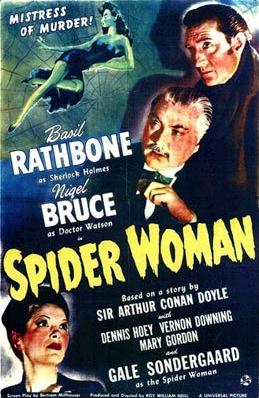
The Spider Woman is a 1943 mystery film starring Basil Rathbone as Sherlock Holmes and Nigel Bruce as Dr. Watson, the seventh of fourteen such films the pair were involved in. As with all of the Universal Studios films in the series, the film is set in then-present day as opposed to the Victorian setting of the original stories. This film incorporates elements from the 1890 novel The Sign of the Four, as well as the short stories "The Final Problem", "The Adventure of the Empty House", "The Adventure of the Speckled Band" and makes explicit reference to "The Adventure of the Devil's Foot".

The Hound of the Baskervilles is a 1939 American gothic mystery film based on the 1902 Sherlock Holmes novel of the same name by Sir Arthur Conan Doyle. Directed by Sidney Lanfield, the film stars Basil Rathbone as Sherlock Holmes and Nigel Bruce as Dr. John Watson. Released by 20th Century Fox, it is the first of fourteen Sherlock Holmes films produced between 1939 and 1946 starring Rathbone and Bruce.

The Adventures of Sherlock Holmes is a 1939 American mystery adventure film based on Sir Arthur Conan Doyle's Sherlock Holmes detective stories. Although claiming to be an adaptation of the 1899 play Sherlock Holmes by William Gillette, the film bears little resemblance to the play.

The House of Fear is a 1945 Sherlock Holmes crime film starring Basil Rathbone and Nigel Bruce. Directed by Roy William Neill, it is loosely based on the 1891 short story "The Five Orange Pips" by Arthur Conan Doyle. It is the 10th film of the Rathbone/Bruce collaboration as Holmes and Dr. Watson.
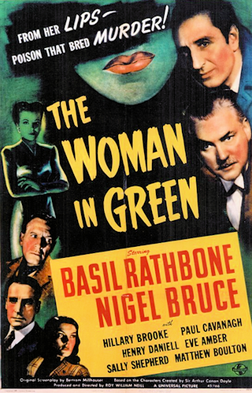
The Woman in Green is a 1945 American film, the eleventh of the fourteen Sherlock Holmes films based on the characters created by Arthur Conan Doyle. Produced and directed by Roy William Neill, it stars Basil Rathbone as Sherlock Holmes and Nigel Bruce as Dr. Watson, with Hillary Brooke as the woman of the title and Henry Daniell as Professor Moriarty. The film follows an original premise with material taken from "The Final Problem" (1893) and "The Adventure of the Cardboard Box.

A series of fourteen films based on Sir Arthur Conan Doyle's Sherlock Holmes stories was released between 1939 and 1946; the British actors Basil Rathbone and Nigel Bruce played Holmes and Dr. John Watson, respectively. The first two films in the series were produced by 20th Century Fox and released in 1939. The studio stopped making the films after these, but Universal Pictures acquired the rights from the Doyle estate and produced a further twelve films.

Sherlock Holmes and the Secret Weapon (1942) is the fourth in the Basil Rathbone/Nigel Bruce series of 14 Sherlock Holmes films which updated the characters created by Sir Arthur Conan Doyle to the then present day. The film is credited as an adaptation of Conan Doyle's 1903 short story "The Adventure of the Dancing Men," though the only element from the source material is the dancing men code. Rather, it is a spy film taking place on the background of the then ongoing Second World War with an original premise. The film concerns the kidnapping of a Swiss scientist by their nemesis Professor Moriarty, to steal a new bomb sight and sell it to Nazi Germany. Sherlock Holmes and Dr. John Watson have to crack a secret code in order to save the country.

Sherlock Holmes and the Voice of Terror is a 1942 American mystery thriller film based on Sir Arthur Conan Doyle's Sherlock Holmes detective stories. The film combines elements of Doyle's short story "His Last Bow", to which it is credited as an adaptation, and the real-life activities of Lord Haw-Haw.
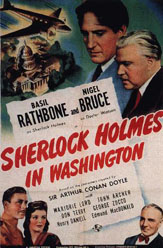
Sherlock Holmes in Washington (1943) is the fifth film in the Basil Rathbone/Nigel Bruce series of Sherlock Holmes movies. The plot is an original story not based on any of Sir Arthur Conan Doyle's Holmes tales.

Pursuit to Algiers (1945) is the twelfth entry in the Basil Rathbone/Nigel Bruce Sherlock Holmes film series of fourteen. Elements in the story pay homage to an otherwise unrecorded affair mentioned by Dr. Watson at the beginning of the 1903 story "The Adventure of the Norwood Builder", notably the steamship Friesland. Off-camera, Watson also recounts to his audience another unrecorded affair mentioned in the 1924 story "The Adventure of the Sussex Vampire", that of the Giant Rat of Sumatra, "a story for which the world is not yet prepared".

Sherlock Holmes Faces Death is the sixth film in the Basil Rathbone/Nigel Bruce series of Sherlock Holmes films. Made in 1943, it is a loose adaptation of Sir Arthur Conan Doyle's Holmes 1893 story "The Adventure of the Musgrave Ritual." Its three immediate predecessors in the film series were World War II spy adventures with Holmes and Dr. Watson helping the Allies thwart enemy agents, but this one marked a return to the pure mystery film form. Though several characters are military men and there are frequent mentions of the ongoing war, it is not the focus of the story.

Silver Blaze is a 1937 British, black-and-white crime and mystery film, based loosely on Arthur Conan Doyle's 1892 short story "The Adventure of Silver Blaze". It was directed by Thomas Bentley, and was produced by Twickenham Film Studios Productions. It stars Arthur Wontner as Sherlock Holmes, and Ian Fleming as Dr. Watson. In the United States, the film was released in 1941 by Astor Pictures, where it was also known as Murder at the Baskervilles, retitled by distributors to capitalize on the success of the Basil Rathbone Holmes film, The Hound of the Baskervilles.

Frederick Worlock was a British-American actor. He is known for his work in various films during the 1940s and 1950s, and as the voice of Horace in One Hundred and One Dalmatians (1961).



















